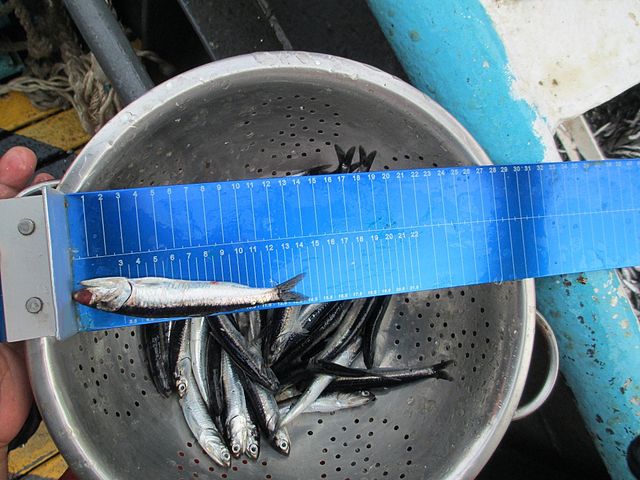Anchovy:
What is it?, history, cultivation, nutritionalvalue, uses, recipes, and more...
The anchovy is a small fish that serves as the primary food source for many marine fish, birds, and mammals. The majority of its production is intended for the production of fishmeal and fish oil for export. Moreover, it is a food with high biological and protein value that provides important components such as Omega 3 and Omega 6 fatty acids.
Índice
What is Anchoveta?
The anchoveta is a small, silver-colored fish measuring 10 to 16 cm in total length. It has a streamlined, laterally compressed body with large eyes. Its head is relatively large and pointed, featuring a significantly sized, subterminal, and ventral mouth.
The dorsal side of the fish is dark blue, distinct from the bright silver sides and belly. It has a dark spot on the upper part of the operculum behind the eye, and its caudal fin is forked and dark in color, while the other fins are light in color.
Its fins only have rays, not spines. The dorsal fin is short and located halfway up the back. The pectoral fins are situated near the ventral edge, and there is also a short anal fin. The pelvic fins are positioned in the mid-ventral region between the pectoral and anal fins.
Anchoveta has large, silver, and deciduous cycloid scales that do not extend towards the head.
History of Anchoveta
The oldest traces of anchoveta consumption on the Peruvian coast have been found in the upper part of the Zaña Valley (Lambayeque Region) with dates ranging between 9700 and 9200 B.C.
Similarly, remains of anchoveta dating back to 5600 B.C. have been located at Huaca Prieta, situated at the southern end of the El Brujo Archaeological Complex (La Libertad Region).
Archaeological sites from the Archaic period (7600 – 1700 B.C.) such as Caral, El Paraíso, and La Paloma, in the central coast of Peru, show anchoveta as the most prevalent fish. Even from that time, it’s believed that anchoveta was one of the most consumed marine species in the ancient Peruvian diet.
During the colonial period, Father Bernabé Cobo in his work “History of the New World” detailed the abundant presence of this fish in the Peruvian sea:
“Such dense schools of anchovetas often come along the coast of Peru, that while I was sailing from Lima to Trujillo in the year 1627, the ship was surrounded by one so large that the water appeared blackened, and because it was calm at that time, people on the ship caught them with baskets, with no more effort than putting the baskets sideways into the sea and pulling them out full of anchovetas.”
During the Viceroyalty era, anchoveta was a very popular food in Lima, and likely in other coastal cities, thanks to its good taste and low cost. It was consumed both fresh in the areas near the coast and sun-dried for distribution to distant places.
The extraction of anchoveta was almost insignificant. It was a common food for the inhabitants of the Peruvian coast until it became important when the global industry discovered that it could be used in the production of high-nutritional value products for animal husbandry.
Between 1950 and 1972, Peru went from extracting 90 thousand tons to producing 14 million tons of anchoveta, first as a private activity and later as a state activity. During this time, the anchoveta oil and meal industry was considered one of the “miracles of the Peruvian economy.” Anchoveta was used to feed guano birds and other fish (a practice that continues).
However, the fishing boom led to overexploitation of the species, and it was declared a “fully exploited” fishery by the Peruvian government in 2009. Maximum volumes of anchoveta that could be extracted and fishing seasons were established.
Today, anchoveta has largely recovered its biomass, and the fishmeal industry has entered a new boom, also benefiting from other species.

Common Name of Anchoveta
| Spanish | Anchoveta, Anchoa, Sardina bocona, Chicoria |
| English | Anchovy, Peruvian anchovy |
Scientific Name of Anchoveta
Engraulis ringens
Taxonomy of Anchoveta
| Kingdom | Animalia |
| Filo | Chordata |
| Class | Actinopterygii |
| Order | Clupeiformes |
| Family | Engraulidae |
| Gender | Engraulis |
| Specie | E. ringens Jenyns, 1842 |
Synonymy of Anchoveta
Anchoviella tapirulus; Cope, 1877.
Engraulis pulchellus Girard, 1855.
Engraulis tapirulus; Cope, 1877.
Stolephorus tapirulus; Cope, 1877.
Engraulis pulchellus, Girard, 1856 (Bahia Caldera, Chile).
Engraulis tapirulus, Cope, 1877 (Bahía Pacasmayo, Perú – identificación
dado por Böhlke, 1984).
Stolephorus tapirulus; Abbott, 1899.
Anchoviella tapirulus; Fowler, 1941.
Engraulis ringens; Delfin, 1901; Jordania y Seale, 1926 (Callao, Perú; en
Panamá es la Anchoa arenicola)
Etymology of Anchoveta
Anchoveta: From “anchova” and -eta. Fish similar to anchovy.
Habitat of Anchoveta
- Habitat
Habitat of Anchoveta
Anchoveta is found throughout the extent of the Peruvian current, also known as the Humboldt current. They are distributed between southern Ecuador and the Aysén region in southern Chile. Usually, they are found within 80 km of the coast, but occasionally venture out as far as 160 km from the shore. Under normal conditions, they are fish that live in schools, swimming close to the surface during the night and descending to depths of up to 50 meters during the day to escape predators.
Anchovetas feed on existing plankton. While they reproduce at any time of the year, the major spawning occurs, one at the end of winter and another at the end of summer. An adult female lays thousands of eggs during her lifetime, spawning both on the surface and down to 50 meters deep. Within six months, they reach a size of 8 cm, 10.5 cm at one year old, and 12 cm at one and a half years old.
Usually, the capture or fishing of this species is done with purse seine nets in industrial fishing and occasionally in artisanal fishing.
Geographical Distribution of Anchoveta

Lima, Arequipa, Tacna, Lambayeque, Callao, Áncash, La Libertad, Piura, Moquegua
Seasonal Availability of Anchoveta
- Available throughout the year.
Nutritional Value of Anchoveta
Anchoveta is a significant source of animal protein, which prevents blood clotting and thus aids in reducing heart problems. Due to its high content of lysine and other essential amino acids, it complements carbohydrate-rich diets. It provides many micronutrients that are not usually found in basic foods.
It also contributes Omega-3 fatty acids, which help combat bad cholesterol and prevent cardiovascular diseases. Additionally, it contains significant concentrations of calcium, phosphorus, potassium, vitamin A, vitamin C, and some B-complex vitamins.
Moreover, it is recommended for the diet of newborns as it promotes nervous tissue formation and aids in visual function. It’s also beneficial for school-age children to enhance their intellectual quotient, and for adults and seniors to improve memory.
Some nutritionists recommend consuming it 2 to 3 times a week to reap its benefits.
Health Benefits of Anchoveta
Anchoveta is rich in high-quality protein. It contains vitamins like A and D, iron, Omega-6, and Omega-3.
Contraindications or Side Effects
There is no evidence to date that its consumption has adverse effects or interactions with medications.
| 10 Porciones por Kilogramo | |
| Tamaño de porción | 100g |
| Cantidad por porción Calorías |
156 |
| Cantidad por 100g | |
| Energía | 651 kJ |
| Grasa Total | 8.2 g |
| Sodio | ● |
| Carbohidratos totales | 0.0 g |
| Carbohidratos disponibles | ● |
| Fibra Dietaria | ● |
| Proteínas | 19.1 g |
| Calcio | 77 mg |
| Fósforo | 276 mg |
| Zinc | 1.72 mg |
| Hierro | 3.04 mg |
| Potasio | ● |
| Agua | 70.8 g |
| Cenizas | 1.2 g |
| Vitamina A | 15 μg |
| Tiamina (B1) | 0.01 mg |
| Riboflavina (B2) | 0.21 mg |
| Niacina (B3) | 0.00 mg |
| Vitamina C | 8.70 mg |
| Acido Fólico (B9) | ● |
| β-Caroteno | 0 μg |
| Fuente: Tablas peruanas de composición de alimentos – Centro Nacional de Alimentación y Nutrición – Ministerio de Salud – Perú | |
Derived Products and Forms of Anchoveta Consumption
Uses of Anchoveta
In Peru, 97% of the total anchoveta volume is used for indirect human consumption, in the form of fishmeal and fish oil. It is also used, to a lesser extent, as a culinary ingredient and harnessed for its nutritional properties.
- Culinary
- Medicinal
- Industrial
Culinary Use of Anchoveta
Although anchoveta is primarily used to produce fishmeal for feeding other species and, to a lesser extent, for human consumption, it is also eaten in its natural state or preserved in preparations such as frying, smoking, stewing, etc.
An indirect culinary use of anchoveta is to sustain the diet of many other species with which national dishes like ceviche, escabeche, tiraditos, among others, are prepared.
Medicinal Use of Anchoveta
Among the first health benefits that anchoveta provides are:
Supplying omega-6 and omega-3, essential fats that the human body produces.
Due to its omega-3 contribution, it is fundamental for brain development and maintaining healthy skin.
It prevents heart diseases associated with elevated cholesterol, as well as the prevention of mental disorders like Alzheimer's and depression.
It contains calcium, phosphorus, potassium, vitamin A, vitamin C, and B-complex vitamins. It also contains minerals, including iron and zinc, as well as proteins.
It is an ideal food for pregnant women, as it enhances the baby's development and strengthens their body during pregnancy.
It prevents diseases of the circulatory or nervous system.
Industrial Use of Anchoveta
The primary industrial use of anchoveta is the production of fishmeal and fish oil. It's worth highlighting that Peru continues to be the world's leading producer of fishmeal and that anchoveta meal is the fifth-largest export product in Peru.
In 2017, only 3% of the production was destined for Direct Human Consumption (DHC), mostly as canned anchoveta, but also in other forms such as fresh, cured, and frozen (Produce, 2018).



